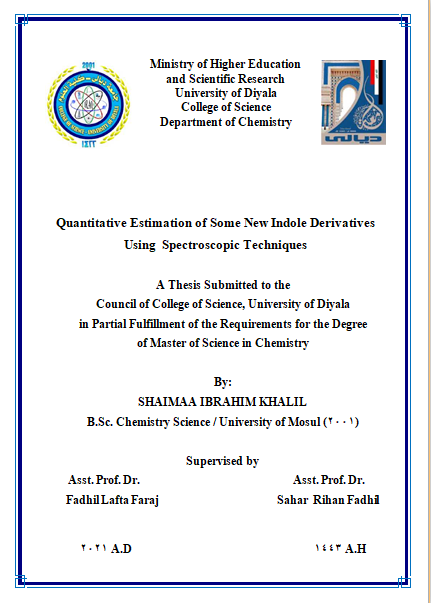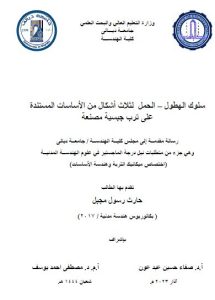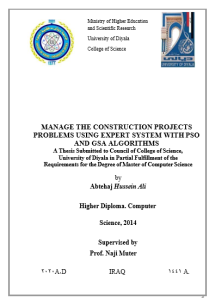ABSTRACT
The current study included the synthesized of novel compounds for Schiff bases from one of the indole derivatives, and this study included the following two sections.
The first section: includes the preparation of the primary material (2-(5-chloro-3,3-dimethylindolin-2-ylidene)malonaldehyde and 2-(5-methoxy-3,3-dimethylindolin-2-ylidene)malonaldehyde )(compound 3,4) in two steps.
The first step is the reaction of 4-(R) phenyl hydrochloride hydrazine with methyl isopropyl ketone in the presence of glacial acetic acid as a solvent to form 2,3,3-trimethyl-5-(R)-3hydro indole(1,2) by Fisher reaction R=Cl,OCH3.
The second step involves the reaction of 2,3,3-trimethyl-5-(R)-3hydroindole (1,2)with phosphoryl chloride in the presence of dimethylformamide as a solvent to form 2-(3,3-dimethyl-5-(R)indole-2-ylene) ) malonaldehyde (3,4) by the reaction of Vilsmeier.
Then, three compounds were prepared from the derivatives of indole Schiff bases (5-7), resulting from the reaction of 2-(3,3- dimethyl-5-(R) indole-2- ylidene) malonaldehyde (3,4) with various substituted o-phenylenediamine in ethanol as a solvent with glacial acetic acid as a catalyst.
The second section: includes the preparation of the primary compound (8) (2-(1,1-dimethyl-1,3-dihydro-2H-benzo[e]indol-2-ylidene)malonaldehyde ) in one step, which is the reaction of 1,1,2-trimethyl-1H-benzo [e] indole with phosphoryl chloride in the presence of dimethylformide as a solvent (Vilsmieir reaction) to form 2-(1,1-dimethyl-1,3-dihydro-2Hbenzo[e]indol-2-ylidene) malonaldehyde (8).
Then, three compounds were prepared from the derivatives of the indole schiff bases (9-11), which resulted from the reaction (8).With various substitutes of ortho-phenylenediamine in ethanol as a solvent with glacial acetic acid as a catalyst.
The new compounds were characterized by infrared (FT-IR) and nuclear magnetic resonance (1HNMR) spectra.
The new compounds were quantitatively estimated using infrared spectroscopy, where the results of this study showed compliance with the Beer-Lambert law, and for ranges of concentrations that ranged between (10-50) micrograms.ml-1 for each compound. The results of the proposed method also showed good accuracy and the possibility of applying the method. Successfully in the quantitative determination of the prepared compounds.
Then the biological activity of some synthesized compounds against two Gram-positive (Gr+ve) isolates, Staphylococcus aureus and Staphylococcus epidermidis, was studied and two gram-negative (Gr-ve) Escherichia coli, Klebsiella sp. r by Disk Diffusion. Three of the synthesized derivatives showed good antibacterial activity.





